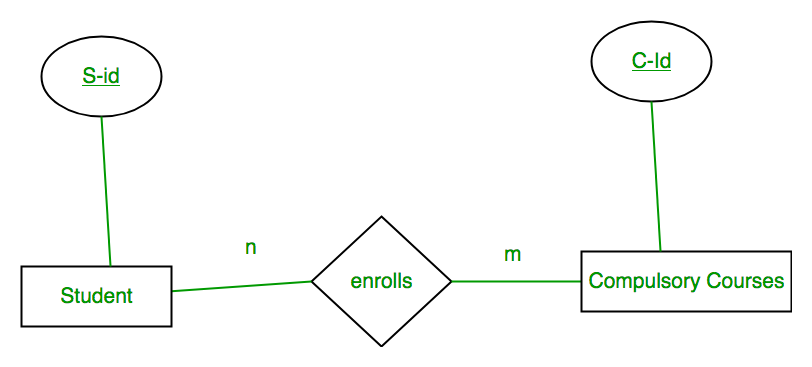
After designing the ER diagram of system, we need to convert it to Relational models which can directly be implemented by any RDBMS like Oracle, MySQL etc. In this article we will discuss how to convert ER diagram to Relational Model for different scenarios.
Case 1: Binary Relationship with 1:1 cardinality with total participation of an entity

A person has 0 or 1 passport number and Passport is always owned by 1 person. So it is 1:1 cardinality with full participation constraint from Passport.
First Convert each entity and relationship to tables. Person table corresponds to Person Entity with key as Per-Id. Similarly Passport table corresponds to Passport Entity with key as Pass-No. Has Table represents relationship between Person and Passport (Which person has which passport). So it will take attribute Per-Id from Person and Pass-No from Passport.

Table 3
As we can see from Table 3, some males and some females do not marry. If we merge 3 tables into 1, for some M-Id, F-Id will be NULL. So there is no attribute which is always not NULL. So we can’t merge all three tables into 1. We can convert into 2 tables. In table 4, M-Id who are married will have F-Id associated. For others, it will be NULL. Table 5 will have information of all females. Primary Keys have been underlined.

Table 6
As we can see from Table 6, S-Id is not repeating in Enrolls Table. So it can be considered as a key of Enrolls table. Both Student and Enrolls Table’s key is same; we can merge it as a single table. The resultant tables are shown in Table 7 and Table 8. Primary Keys have been underlined.

Table 9
As we can see from Table 9, S-Id and C-Id both are repeating in Enrolls Table. But its combination is unique; so it can be considered as a key of Enrolls table. All tables’ keys are different, these can’t be merged. Primary Keys of all tables have been underlined.
Case 5: Binary Relationship with weak entity

In this scenario, an employee can have many dependents and one dependent can depend on one employee. A dependent does not have any existence without an employee (e.g; you as a child can be dependent of your father in his company). So it will be a weak entity and its participation will always be total. Weak Entity does not have key of its own. So its key will be combination of key of its identifying entity (E-Id of Employee in this case) and its partial key (D-Name).
First Convert each entity and relationship to tables. Employee table corresponds to Employee Entity with key as E-Id. Similarly Dependents table corresponds to Dependent Entity with key as D-Name and E-Id. Has Table represents relationship between Employee and Dependents (Which employee has which dependents). So it will take attribute E-Id from Employee and D-Name from Dependents.
| Employee | Has | Dependents | ||||
| E-Id | Other Employee Attribute | E-Id | D-Name | D-Name | E-Id | Other DependentsAttribute |
| E1 | – | E1 | RAM | RAM | E1 | – |
| E2 | – | E1 | SRINI | SRINI | E1 | – |
| E3 | – | E2 | RAM | RAM | E2 | – |
| E3 | ASHISH | ASHISH | E3 | – | ||
Table 10
As we can see from Table 10, E-Id, D-Name is key for Has as well as Dependents Table. So we can merge these two into 1. So the resultant tables are shown in Tables 11 and 12. Primary Keys of all tables have been underlined.
| E-Id | Other Employee Attribute |
Table 11
| D-Name | E-Id | Other DependentsAttribute |
Table 12